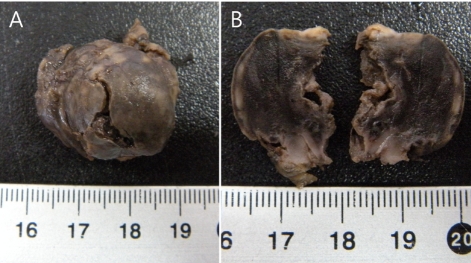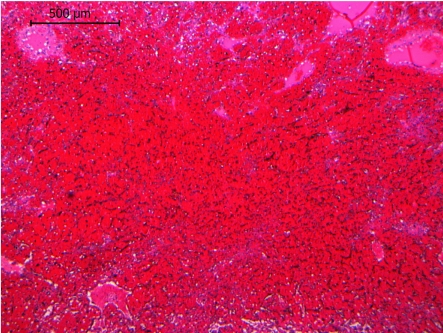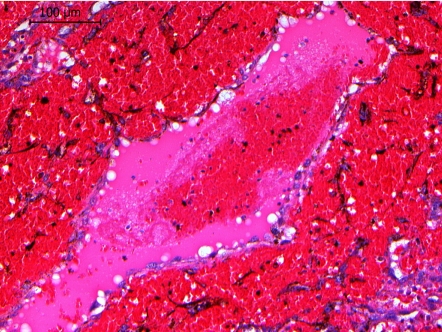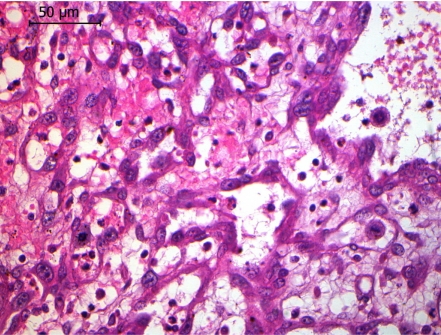Abstract
A fourteen-year female Jindo dog showing signs of hemoperitoneum was diagnosed with hemangiosarcoma through abdominal radiography and histopathological examination. In the abdominal radiographs, a circular mass was observed on the posterior of the spleen. When the splenic mass was removed via laparotomy, it was spherical, poorly circumscribed, and showed signs of necrosis, with white spots present on the outer side of the mass. Microscopically, the mass showed that hemorrhage was widespread and extensive infiltration of neoplastic cells was found throughout. There was hypercellularity, including occasional pleomorphic cells and mitotic figures. Inflammation at the edge of the mass, along with necrosis, was also found. In this report, we describe the gross and histopathological findings of a case of canine hemangiosarcoma.
Canine hemangiosarcoma is a common type of cancer that originates from blood vessels [1-3]. It can occur in any bodily blood vessels and can be categorized into two groups: cutaneous and visceral hemangiosarcoma. In cutaneous hemangiosarcoma, a neoplasm develops on the skin while in visceral hemangiosarcoma a neoplasm commonly occurs in the canine spleen, heart, or kidneys. Visceral hemangiosarcoma is the more aggressive type and has a higher chance of metastasis, with poor prognosis [4,5]. The cause of hemangiosarcoma has not yet been clearly defined. It is more prevalent in elder dogs, especially spayed females between 8 and 13 years, and in large breed dogs such as German Shepherds and Golden Retrievers [6,7].
Before surgery, serum chemistry results showed the dog had anemia with hematocrit 11.3% and hemoglobin 3.6 g/dL, inflammation with increased white blood cells 45.3×109/L (reference range: 6.0-16.9×109/L), and a high level of alkaline phosphatase, 419 U/L (reference range: 23-212 U/L). Radiography revealed a circular mass on the spleen posterior.
The mass was surgically removed and then fixed in 10% neutral buffered formalin for 24 h, before being processed and embedded in paraffin wax. After being sectioned at 4 µm thickness, the sections were stained with hematoxylin and eosin for microscopic analysis.
The mass was approximately 3×2.5×1.5 cm in size. Because it developed in spleen, where there are many red blood cells exposed to oxygen, it was mostly brown with white spots of necrosis appearing on the outer side of the spherical mass (Figure 1).
Tissue showed signs of hemorrhage, with a significant amount of blood outside the blood vessels throughout the sample. Both the rupture and poor blood vessel formation in the neoplastic cells could have been responsible for the extensive hemorrhage. The tumor was poorly circumscribed and the normal morphological features of the spleen were hard to find due to both the hemorrhage and the infiltration of neoplastic cells (Figure 2). The mass also showed inflammation, with clusters of neutrophils and a large necrotic area on the outer side that was devoid of cells (Figure 3). Large numbers of pleomorphic cells, both polygonal and round, with eosinophilic cytoplasm and vesicular nuclei were observed, some of which had occasionally formed channels filled with red blood cells, plasma, and a small number of white blood cells (Figure 4).
Mitotic figures indicating rapid growth were frequently found where the cell population was relatively high (Figure 5). Moderate anisocytosis and anisokaryosis were also found, which could have resulted from the uncontrolled and uneven development of neoplastic cells.
Based on these findings, the Jindo dog was diagnosed with canine splenic hemangiosarcoma. Hemangiosarcoma is a malignant neoplasm that arises from vascular endothelial tissue [1,2,5]. According to past study, the majority of canine hemangiosarcoma cases occur in the spleen [5,6]. In this research, more than 55% of dogs were diagnosed due to a rupture of the primary or metastatic tumor [6]. Of the 104 dogs considered, 100 were dead within four months of diagnosis and the remaining four barely survived a year on average [6]. Although canine hemangiosarcoma is considered fairly common, it is an aggressive sarcoma type that often leads to metastasis. It has a poor prognosis once discovered because a dog with hemangiosarcoma will show little or no clinical signs until a rupture of the mass leads to hemoabdomen [1,4]. However, close clinical attention and observation, combined with various diagnostic techniques such as ultrasonography and biopsy could help with early diagnosis and thus improve survival rates.
Acknowledgments
This work was supported by the Basic Science Research Program through the National Research Foundation of Korea (NRF), funded by the Ministry of Education, Science and Technology (2011-0025973).
References
1. Clifford CA. Treatment of canine hemangiosarcoma: 2000 and beyond. J Vet Intern Med. 2000; 14(5):479–485. PMID: 11012108.

2. Meuten DJ. Tumors of Domestic Animals. 2002. 4th ed. Iowa: Iowa State Press;p. 45–117.
3. Mitchell BE. The Veterinary Clinics of North America, Small Animal Practice. 2003. Philadelphia: WB Saunders;p. 533–552.
4. Maxie MG. Jubb, Kennedym and Palmer's Pathology of Domestic Animals. 2007. volume 3:5th ed. St. Louis: Saunders Elsevier;p. 102–105.
5. Withrow SJ. Wtihrow and MacEwen's Small Animal Clinical Oncology. 2007. 4th ed. St. Louis: Saunders Elsevier;p. 785–795.
6. Brown NO, Patnaik AK, MacEwen EG. Canine Hemangiosarcoma: Retrospective analysis of 104 cases. J Am Vet Med Assoc. 1985; 186:56–58. PMID: 4038395.
7. Prymak C, McKee LJ, Goldschmidt MH, Glickman LT. Epidemiologic, clinical, pathologic, and prognostic characteristics of splenic hemangiosarcoma and splenic hematoma in dogs: 217 cases (1985). J Am Vet Med Assoc. 1988; 193:706–712. PMID: 3192450.
Figure 1
Gross findings in the spherical mass. (A) The spherical mass was removed from the spleen. (B) The cut surface shows white spots on the edge, indicating necrosis.

Figure 2
Hemorrhage was widespread, making it hard to recognize the normal splenic structure. H&E stain. Scale bar=500 µm.

Figure 3
Inflammation and edema were noted with the infiltration of neutrophils and the lack of cell population on the mass edge. H&E stain. Scale bar=50 µm.





 PDF
PDF ePub
ePub Citation
Citation Print
Print




 XML Download
XML Download